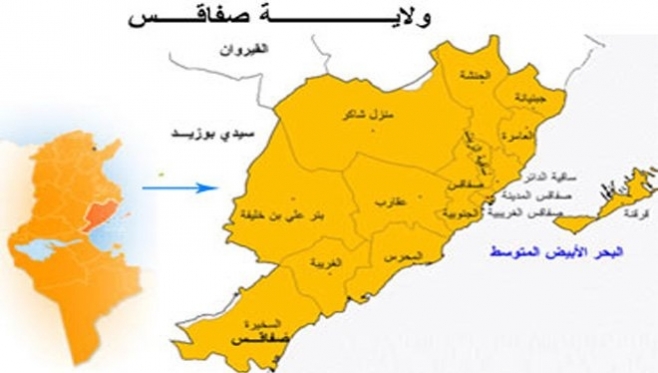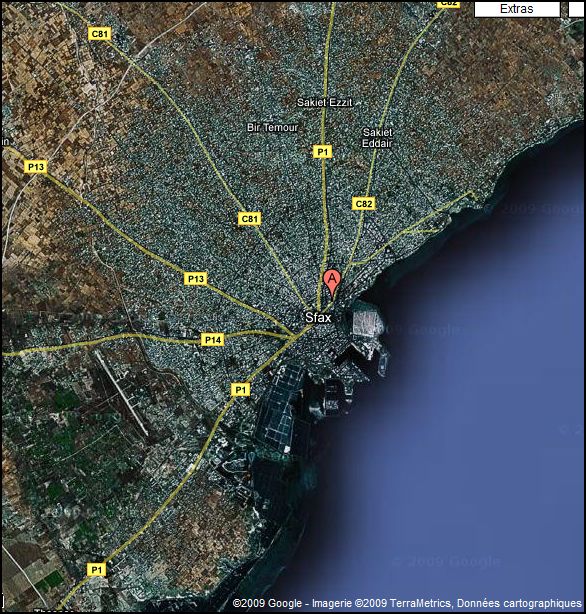Definition of the city
Sfax is located 270 km from Tunis and its coast extends 200km. It is boarded by the sea in the East, the state of Mahdia in the North, the state of Kairouan, Sidi Bouzid and Gafsa in the West and the state of Gabes in the south.
The city of sfax is considered the Capital of a region that mediates between the Coast and the South of Tunisia and also between the grounds and the sea. Perhaps, the Kerkennah arkhabil “Sarsena” highlights the absolute authority of the sea over the history of this side.
Sfax is the second most important city in Tunisia geographically, economically and culturally, with its coasts overlooking the Mediterranean Sea extending over 235 km.
The Roman and Byzantine civilizations rolled out and their evidence is still in the Archaeological cities of Tina and Bateria. Its prosperous Islamic history began in the Aghlabid era when the Great Mosque and the Wall were founded in 849 CE.
Sfax has a population of about one million, representing about 9% of the country's population.
It has been known, since ancient times, for its economic activity thanks to its economic and commercial role that it played between cities of the South and the North and its reception For Mediterranean merchants on its open coasts and the city’s history.
Sfax, the safeguarding city, the capital of southern Tunisia, extends over an area of 7,545 km2 and has more than one million inhabitant. Sfax is located 270 km from Tunis, and its coast extends 200 km. It is bordered by the sea in the east, the state of Mahdia in the north, the states of Kairouan, Sidi Bouzid, Gafsa in the west, and the state of Gabes in the south.
Sfax was known by its barbarian name »Syfax ».Its Roman name is “Taparura”.It’s a city in which different peoples and many civilizations are mixed. Life in the two cities Tina and Taparura depended on agriculture as well as on marine fishing as olive. cultivation was flourishing. It also depended on vineyards and figs cultivation. The land and sea products have resulted in a thriving trade with merchants who come from Athens and Alexandria, thanks to the protection provided by the coast of Taparura from the natural barrier represented by the Kerkennah Islands. This has had a great impact in enriching its economic and cultural life. Sfax entered the written history in 856 AD, when the city fences and its great mosque were built. In the 12th century: the Normans from Sicily dominated the city. However, this did not last long, as it was liberated during the period of Ben Ali Abd al-Mumin, the founder of the Almowahad state - Hafsid period: witnessed the restoration of monuments and the rebuilding of the walls in stone. Trade has also flourished, as it has become a major activity for the people of Sfax.
In the 17th century: Trade exchanges with Istanbul and Damascus flourished, as well as with Marseille and Ginoua. Moreover, Sfax established a sea-line after the attacks of Christian ships. Ali Pasha and Hammouda Pasha assigned this fleet missions to Gabes Bay.
In the 18th century: the city of Sfax witnessed a tangible prosperity. The city expanded with the emergence of a new neighbourhood "tribal crouching" as the "tower" became the main residence of the Sfaxians who devoted themselves to animal husbandry and land service. Colonialism had also left its effects, especially through architecture, creating a new city on the sea side and a commercial port for Allies and phosphates. The manufacturing industries have also evolved and the olive cultivation strengthened.
In the 19th century: Jews and Christians came to Sfax, especially from Malta, and settled there. Their activity remained limited until the French protectorate erected in 1881.



